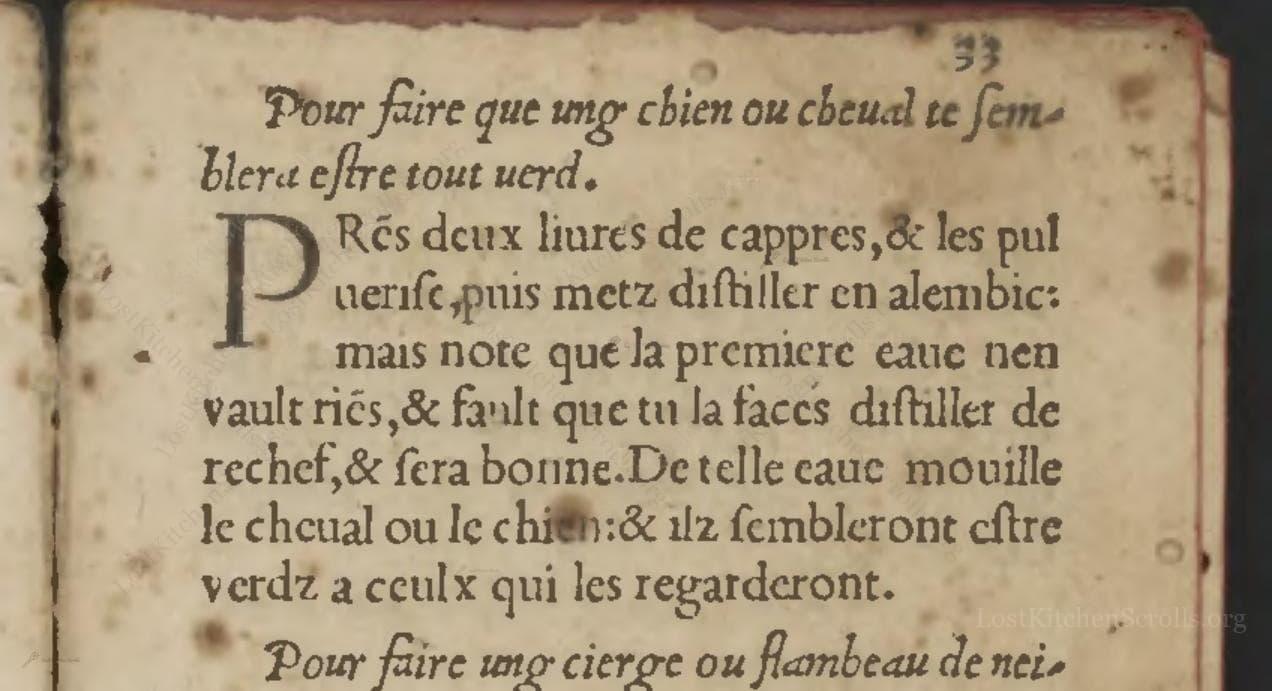Pour Faire Que Ung Chien Ou Cheual Te Semblera Estre Tout Uerd
"To Make A Dog Or Horse Appear To You To Be Completely Green"
From the treasured pages of Bastiment de receptes
Unknown Author

Pour Faire Que Ung Chien Ou Cheual Te Semblera Estre Tout Uerd
"Prés deux liures de cappres, & les puluerise, puis metz distiller en alembic: mais note que la premiere eaue nen vault riens, & fault que tu la faces distiller de rechef, & sera bonne. De telle eaue mouille le cheual ou le chien: & ilz sembleront estre verdz a ceulx qui les regarderont."
English Translation
"To make a dog or horse appear to you to be completely green. Take two pounds of capers and pulverize them, then put them to distill in an alembic; but note that the first water is worth nothing, and you must distill it again, and then it will be good. With this water, wet the horse or the dog, and they will seem green to those who look at them."
Note on the Original Text
The recipe is written in the pithy, direct style typical of early modern European cookery and secrets books, often skipping explicit measurements and assuming the reader’s familiarity with processes like distillation. Spellings reflect 16th-century French conventions ('cheual' for 'cheval', 'u' for 'v', 'cappres' for 'capres'). The text also assumes access to alchemical or apothecary equipment, which was common for learned households of the period. The magical claims of the effect are written in earnest but should be read with a grain of salt, recognizing the era's love of marvels and visual trickery.

Title
Bastiment de receptes (1541)
You can also click the book image above to peruse the original tome
Writer
Unknown
Era
1541
Publisher
A Lescu de Coloigne
Background
Step into the culinary secrets of Renaissance France! 'Bastiment de receptes' is a delectable compendium newly translated from Italian, brimming with recipes, curious odors, and medicinal tidbits designed to both delight the palate and preserve health.
Kindly made available by
Library of Congress
This recipe hails from 'Bastiment de receptes,' printed in Lyon in 1541 and based on a translation from Italian into French. A compendium of secrets and curiosities, the book collects not merely medicinal formulas but also playful and wondrous tricks, such as this illusion for making animals look green. Such recipes reflect the fascination of Renaissance Europe with alchemy, transformation, and sensory deception, blending practical experimentation with a sense of marvel and humor. Rather than intending harm or dietary sustenance, the aim here is to delight—and possibly astonish—a dinner guest or passerby.

The key tool for this recipe would have been the alembic, a simple distillation apparatus made of glass or copper in the 16th century. For pulverizing the capers, a sturdy mortar and pestle—stone or wooden—was used. Once pulverized, the mixture would be heated over a fire, the vapors condensed and collected as distillate. Cloths or sponges likely aided in applying the resulting liquid to the animal’s coat.
Prep Time
15 mins
Cook Time
1 hr
Servings
1
We've done our best to adapt this historical recipe for modern kitchens, but some details may still need refinement. We warmly welcome feedback from fellow cooks and culinary historians — your insights support the entire community!
Ingredients
- 2 pounds capers
- Water (for distillation; quantity as needed)
Instructions
- To make an animal such as a dog or a horse appear green to the viewer, begin by taking approximately 2 pounds of capers and pulverizing them into a coarse powder with a mortar and pestle or a food processor.
- Place the mashed capers into a modern distillation apparatus, such as a glass still or alembic if available.
- Distill the mixture, but discard the first distillate, as this initial liquid is considered ineffective.
- Collect the liquid from the second distillation, as this is the sought-after extract.
- Finally, use this greenish water to moisten the coat of the dog or horse—according to the recipe, to those who look upon the animal, it will appear green.
- Note: While the resulting effect is most likely subtle and may have been enhanced by expectation or a trick of the light, one could test the effect by applying the caper distillate to fur or hair in a safe and controlled manner.
Cooking Estimates
You will spend a short time crushing the capers and setting up the distillation. The actual distillation takes the longest time but does not need much effort once started. Capers do not have many calories and the extract is not meant for eating, so calories are close to zero.
As noted above, we have made our best effort to translate and adapt this historical recipe for modern kitchens, taking into account ingredients nowadays, cooking techniques, measurements, and so on. However, historical recipes often contain assumptions that require interpretation.
We'd love for anyone to help improve these adaptations. Community contributions are highly welcome. If you have suggestions, corrections, or cooking tips based on your experience with this recipe, please share them below.
Join the Discussion
Rate This Recipe
Dietary Preference
Main Ingredients
Culinary Technique
Occasions

Den Bockfisch In Einer Fleisch Suppen Zu Kochen
This recipe hails from a German manuscript cookbook compiled in 1696, a time whe...

Die Grieß Nudlen Zumachen
This recipe comes from a rather mysterious manuscript cookbook, penned anonymous...

Ein Boudain
This recipe comes from an anonymous German-language manuscript cookbook from 169...

Ein Gesaltzen Citroni
This recipe, dating from 1696, comes from an extensive anonymous German cookbook...
Browse our complete collection of time-honored recipes



